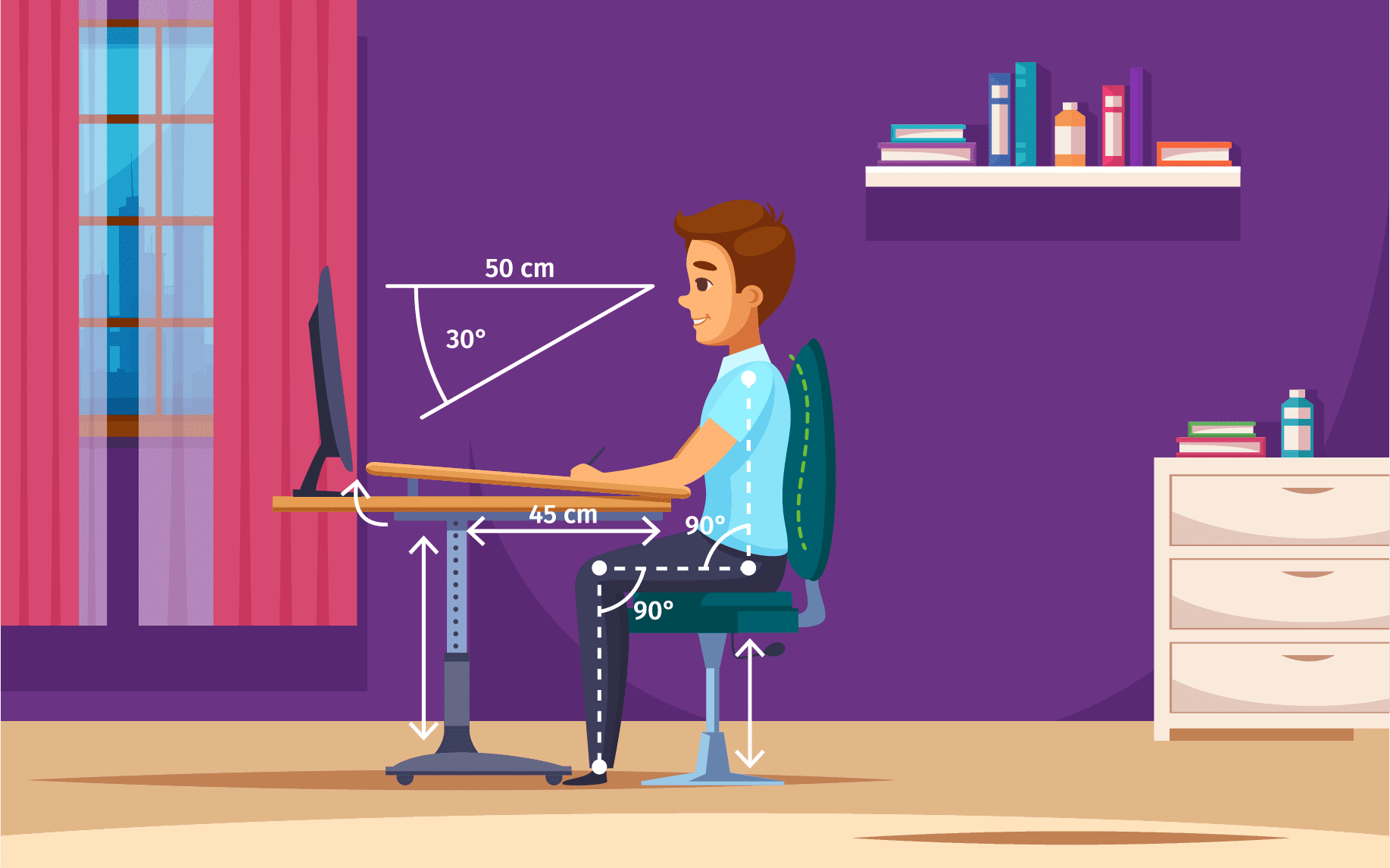Maintaining good posture while studying is more important than most people think. Whether you’re a student, a professional, or a lifelong learner, sitting for long hours can take a toll on your health. Poor posture can lead to back pain, fatigue, headaches, and even decreased concentration. On the other hand, good posture boosts energy, prevents pain, and keeps your mind sharp.
In this blog, we’ll walk through the right ways to maintain good posture while studying and why it matters. This guide is simple enough for everyone, from kids to adults, and backed by reliable sources.
What Is Good Posture?
Good posture means keeping your body aligned so your muscles and ligaments can work efficiently and without strain. When sitting, this means your back is straight, shoulders relaxed, and feet flat on the floor. Your neck should be aligned with your spine, and your screen or book should be at eye level. This alignment helps distribute your body weight evenly, reducing the risk of physical stress or injury.
According to the American Chiropractic Association, good posture helps keep your bones and joints in the correct alignment, which ensures muscles are used properly and efficiently.
Why Posture Matters While Studying
Studying often involves long hours of sitting, reading, writing, or using a computer. Poor posture during these activities can lead to:
- Back and neck pain
- Shoulder stiffness
- Eye strain and headaches
- Fatigue and low energy
- Reduced focus and productivity
Research from the National Institutes of Health (NIH) shows that incorrect posture while sitting can lead to musculoskeletal disorders over time.
By maintaining good posture, you’re not just helping your body—you’re helping your brain stay more alert and engaged.
Setting Up Your Study Space
One of the first steps to maintaining good posture is creating an ergonomic study setup. Ergonomics is the science of designing a workspace that supports your body and promotes comfort.
Here’s what you should keep in mind:
1. Chair:
Choose a chair that supports your lower back. Your knees should be at a 90-degree angle with your feet flat on the ground. Avoid soft couches or beds—they make it hard to sit upright for long.
2. Desk Height:
The desk should be at a height where your elbows are also at a 90-degree angle while typing or writing. Your forearms should rest gently on the desk.
3. Screen or Book Placement:
The top of your screen or book should be at or just below eye level. This prevents neck strain. If needed, use a laptop stand, book holder, or a few stacked books.
4. Lighting:
Good lighting reduces the need to bend forward or squint. Natural light is best, but a bright desk lamp works well too.
How to Sit Correctly While Studying
Once your space is set up, follow these simple steps to maintain good posture:
- Sit back in your chair with your back straight.
- Keep your feet flat on the floor or a footrest.
- Rest your arms comfortably on the desk.
- Avoid slouching, leaning too far forward, or leaning to one side.
- Keep your screen or book at eye level.
- Take deep breaths and relax your shoulders.
Also, avoid crossing your legs for long periods—it can affect circulation and cause misalignment in your spine.
The Role of Breaks and Movement
Even the best posture won’t help if you sit for hours without moving. Our bodies are built to move. Sitting too long in one position slows circulation and puts pressure on the spine and hips.
Follow the 20-20-20 rule for eye health and posture:
- Every 20 minutes, take a 20-second break to look at something 20 feet away.
Additionally:
- Stand up and stretch every 30 to 60 minutes.
- Take short walks around the room.
- Do neck rolls, shoulder shrugs, and back stretches.
Movement refreshes your mind and keeps your muscles active and pain-free.
Posture Exercises to Strengthen Your Back
Good posture also depends on strong muscles, especially in your core and back. Here are a few simple exercises you can do daily:
1. Wall Angels:
Stand against a wall with your arms raised like a goalpost. Slowly move your arms up and down while keeping your back and arms against the wall.
2. Planks:
Hold your body in a straight line on your elbows and toes. This strengthens your core, which supports good posture.
3. Shoulder Blade Squeezes:
Sit up straight and squeeze your shoulder blades together for a few seconds, then release. Repeat 10 times.
Doing these exercises just 5–10 minutes a day can greatly improve your posture over time.
Avoiding Common Posture Mistakes
Here are some habits to watch out for while studying:
- Hunching over your desk: Causes neck and upper back strain.
- Leaning on one elbow: Creates uneven pressure on the spine.
- Using a bed or couch for studying: Leads to slouching and discomfort.
- Holding your phone or tablet too low: Encourages “text neck,” a modern condition caused by bending the neck down for long periods.
By being aware of these habits, you can make small corrections throughout the day.
Using Tools and Gadgets Wisely
Several tools can help maintain posture while studying:
- Ergonomic chairs with lumbar support
- Laptop stands to raise the screen height
- Footrests to support the leg position
- Posture correctors (if recommended by a doctor)
However, gadgets should never replace mindful sitting habits. Technology can assist, but isn’t a substitute for body awareness and regular movement.
Encouraging Good Posture in Kids and Teens
Children are especially vulnerable to developing poor posture due to growing bodies, heavy backpacks, and increased screen time. Parents and teachers can help by:
- Providing child-sized chairs and desks at home
- Limiting screen time
- Encouraging active play and physical activity
- Teaching simple posture habits early
According to the American Academy of Paediatrics, early education on posture can prevent back issues later in life (source).
Final Thoughts
Maintaining good posture while studying is not just about comfort—it’s about long-term health and effective learning. With the right setup, regular movement, and some awareness, anyone can improve their posture and avoid the negative effects of prolonged sitting.
Remember, small daily habits can lead to big results over time. So the next time you sit down to study, take a moment to sit up straight, lift your chin, and feel the difference.
The Best Way to Manage Studies and Work
References
- American Chiropractic Association – www.acatoday.org
- National Institutes of Health – www.ncbi.nlm.nih.gov
- American Academy of Paediatrics – publications.aap.org
- Mayo Clinic – “Posture tips” – www.mayoclinic.org
- Harvard Health Publishing – www.health.harvard.edu

